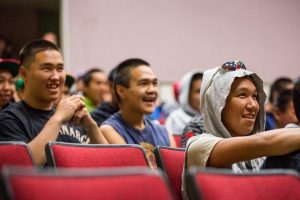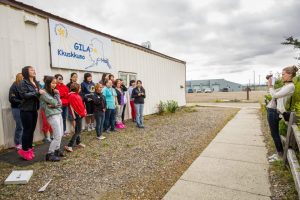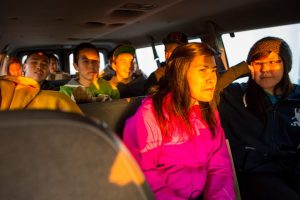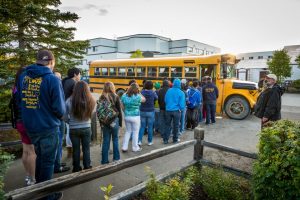Alaska school a beacon of hope after flood waters recede
GALENA — Seventeen-year-old Anthony Solomon was not afraid in May as he watched the Yukon River crest its banks and pour destruction into the streets of his hometown; he knew the Interior Alaska community would never forget that day.
“It was pretty crazy,” he said of May 27, when water flooded homes in a matter of minutes, and massive ice chunks crashed into buildings and onto roads, spilling out from the Yukon due to an ice blockage downstream. Solomon knew that witnessing the flood was a “once-in-a-lifetime” opportunity, one he wasn’t about to miss.
State officials say the Yukon River flooding of spring 2013, in terms of cost and damage, is one of Alaska’s worst natural disasters since 1964, when the Good Friday earthquake ravaged Southcentral Alaska. Flooding hit the communities of Circle, Eagle, Fort Yukon and Hughes, and left almost every structure in Galena damaged in its wake.
Yet in the Bush community of about 500 people, where residents face brutally cold Interior winters and the only way in or out is by boat or plane, the surroundings necessitate a can-do attitude, one where folks can spot opportunity a mile away. Even amid a flood.
This eye for opportunity is nowhere more apparent than within the Galena school system, and at the Galena Interior Learning Academy (GILA), the town’s boarding school, which was brought to life using the infrastructure of an abandoned U.S. Air Force base and now serves as an educational hub for rural and urban students alike.
In the aftermath of the flood, GILA dorms and its dining hall became the lifeline for displaced residents, housing and feeding people who had nowhere else to go. While nearly every structure in the community was damaged in some way by the flood, GILA was spared, thanks to a dike wall that surrounds the airport, the school and some BLM buildings.
Now, the Galena school system offers another kind of shelter for the community — a return to normalcy, an economic driver, and the opportunity for students to pursue a unique education.
After the flood, Solomon’s home was damaged and most of his possessions lost — though he managed to save both his snowmachine and four-wheeler. Nonetheless, Solomon chose to return to the Galena and live in GILA’s dormitory, while his mother remains in Fairbanks for the winter, about 275 miles to the west. “I didn’t want to go to school (in Fairbanks),” he said.
He’s not alone. Students from Anchorage to Hooper Bay flock to Galena for the uncommon educational opportunities nestled in the vast expanse of Interior boreal forest. What takes them there?
Culinary arts, aviation, and cosmetology
“I came here to have a better future,” said 14-year-old Kateri Beans, sitting at a round stone table outside of a dormitory on the first day of school and bubbling with excitement.
Beans is from Mountain Village, located near the mouth of the Yukon River. She describes the school there as “easy work” offering only the most basic courses. Like many GILA students, Beans already knew a familiar face when she arrived, a cousin who is also attending the school.
As a freshman, this is Bean’s first year in Galena. So far, she says it is “beautiful, everyone’s nice, (and) the staff is awesome.”
School started three weeks late this year, on Sept. 9. “I was worried that I couldn’t come,” Beans said, and fretted that her opportunity would be wiped away by the flood, along with the rest of the community. Now, Beans hopes to get a vocational certificate in cosmetology, one of seven vocational certifications offered to students.
The vocational certificates are what truly sets the Galena school system apart. Superintendent Chris Reitan called the program the “biggest draw” for students, offering teenagers the chance to graduate from high school with industry-standard certification.
Graduate from the aviation program, for instance, and a student can walk away with not only a high school degree but also a private pilot’s license.
Besides cosmetology, there are six other vocational certificates available: culinary arts, aviation, applied mechanics, construction technology — referred to by students as “welding” — health science and computer science. All students within the school system have the opportunity to receive vocational certificates; even long-distance students can choose to travel to Galena and attend practicum mini-courses.
And the programs are adaptable, too.
Emilia Brees, a 16-year-old junior from Fairbanks with pink hair and an eyebrow ring, initially came to GILA to study welding, but found herself drawn to culinary arts.
“I always wanted to be a pastry chef, but I’m diabetic,” she said. With the help of Suzette Rosecrans, the culinary arts instructor’s wife, the school crafted a schedule to let her focus her culinary arts work on diabetic-friendly desserts.
“The fact that they’re so willing to change it” means a lot to Brees, who hailed the “one-on-one time” with staff as one of the best aspects of the school.
Utuq Moto, a 17-year-old originally from Deering, came to GILA from the Southcentral community of Ninilchik to experience “something new.” So far GILA is a “big improvement” over the public schools he’s attended, he said.
He will be pursuing welding for his vocational certificate; meanwhile, his involvement in the Native Youth Olympics has also garnered him a role as a leader for a team of students traveling to the games this year.
“I’ll get a good team together,” he said while tying up his shoelaces in the noisy school gym last week. For his efforts, he’ll receive half an elective credit.
Respite and rebuilding
In the months after the flood, while residents took shelter at GILA, culinary arts instructor Rand Rosecrans took the lead on feeding the displaced. In between working on his own home, he fed around 120 people three times a day, alongside his dedicated staff.
Now, the school offers another kind of respite — a chance to switch gears, to have something to focus on besides the rebuilding process.
Rosecrans is back to feeding students and running the culinary arts program. He called the students “my career and my life.”
“It’s nice to have distraction of the work we all signed up for,” Reitan, the superintendent said. His home was destroyed, flooded with six feet of water. He will have to rebuild next summer.
The school system benefits both students and the community at large. All in all, the school district employs 100 people — roughly 20 percent of Galena’s population — although some staff fly in just for the school year. Sept. 9 was always the goal for resuming school, residence life director Ken Essex said, and planning a date in many ways made it happen.
With school open, students’ customary help in the community is more urgent — “because of the flood, students are busy trying to help people,” staff member Vera Rose Mountain said. Topping the list is chopping firewood, which washed away in the flood waters and is a main source of heat for the community.
‘Come Hell or high water’
The seeds of Galena’s public school system were planted in the 1960s, when Sidney Huntington moved to the community. Huntington, now a 98-year-old elder, is regarded as the school system’s founding father. When Huntington first set foot in Galena, he was greeted by appalling educational standards.
“I said then: We’ll put that behind us come hell or high water,” Huntington said.
The Sidney C. Huntington School opened in 1977 and remains in the same one-story building.
When the Galena Air Force Base shuttered its doors in 1993, near the end of the Cold War, what was left behind included dormitories, a dining hall that can seat hundreds, and at least a dozen other buildings. They presented Huntington and other community leaders a rare opportunity to transform the old base into something new.
Four years later, the school operating out of the abandoned infrastructure began serving 40 kids. Today, the base has been converted into the public school known as GILA, serving more than 200 students from across Alaska. The base was officially handed over to the school system in 2008.
The base offers more than enough infrastructure for the school’s needs — GILA is using around 10 of the buildings, with others scattered across the property left unused. GILA always has a waiting list, and students aren’t accepted based on their grades, Essex said, but on how well suited they are for the school.
About two miles down a dirt road, the Sidney C. Huntington school offers K-12 education to 75 local students. The two schools function “like two campuses of one high school,” Reitan said.
The school system also has a home-school program, the Interior Distance Education of Alaska, which serves 3,500 students across the state. All three schools — GILA, Sidney Huntington, and the long-distance program — are public schools.
GILA is now often compared to Mount Edgecumbe in Sitka, another Alaska boarding school with a reputation for high educational standards that attracts students from around the state.
After 50 years of work, “I think we’re on the right track,” Huntington said.
Contact Laurel Andrews at laurel(at)alaskadispatch.com

















